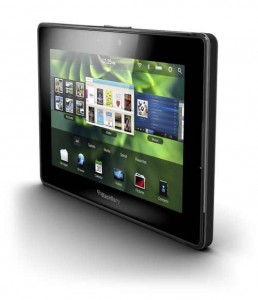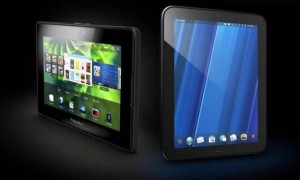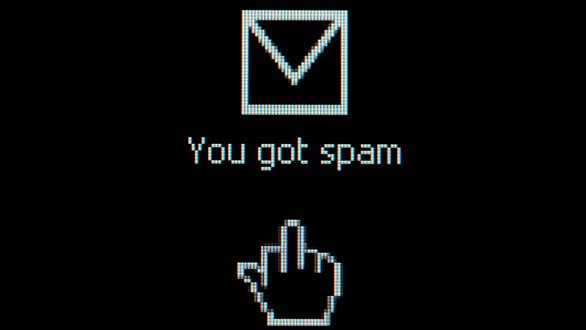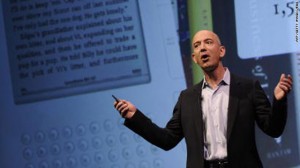The iPad finally has some competition. After dominating the tablet market since its inception, the iPad’s one-year anniversary will bring major competition, including RIM’s BlackBerry PlayBook, Motorola’s Xoom, and Dell’s Streak 7. We lined them all up to see whether any of them will ultimately manage to topple the reigning champ.
That said, the iPad actually has a bit of an artificial disadvantage in this comparison, because it’s old and up for replacement soon, while the others are brand new. It will largely be the iPad 2 that will be competing with the other tablets on the list, so I’ll try to add what I think will be in the iPad 2 as we go through the comparison to provide more balance. I’ve had the Dell Streak 7 for several days, and have an iPad in house, but have not used the Playbook or Xoom so will be working off of known stats entirely for these devices.
We’re going to look at screen size, network performance, processor performance, whether they can be tethered, DLNA support, operating system, number of apps, Flash support, cameras and quality, sensors, max storage, portability and battery life. This is in no particular order.
Screen size
The Streak 7 and Playbook both have 7-inch screens, bringing them more in line with the original Kindle form factor. Due to weight, this is better for books and for women who want to be able to put one in a purse. For men, you could put it in a coat pocket, but it clearly wouldn’t be as portable as the Streak 5, and Dell has a line that will include a 10-inch product later in the year. Dell’s advantage over the other players, at least initially, will be one of choice, and they maintain a consistent user experience across the line. Ideally, you might buy several and pick the one that most fit what you wanted to do, but at initial prices, I doubt there will be many who can afford to try this.
Seven-inch and smaller screens are better for use that is closer to a radio, video player or e-reader. Ten-inch screens are better for Web surfing, note taking, light productivity, and viewing digital pictures. You’re more likely to carry a 7-inch tablet as a supplement to a laptop, and a 10-inch tablet on its own. It depends what you want to do, kind of like comparing a sports car and an SUV.
Network performance
These things live off the Web, and the faster the better. All but the iPad are 4G devices, but I’m expecting the iPad 2 to close this gap by adding 4G. Initially the Streak 7, Xoom, and Playbook will have an advantage here, but they will likely lose it before the year is half over.
Processor performance
The only product that doesn’t have a new dual-core processor is the iPad, and both the Xoom and the Streak 7 have Tegra 2 chips, which deliver strong graphics. Multiple cores provide better multi-tasking performance. Historically, the primary benefit of that is the ability to use anti-malware products (the Streak 7 ships with one) without bringing down system performance critically. This last point is becoming more important as hackers focus more and more on these emerging platforms.
Tethering
The smaller the device, the more tethering makes sense to me, because I have no desire to pay for multiple data plans. Both the Streak 7 and the Xoom provide tethering for up to 5 devices, but the smaller Streak may be more useful, because its small size makes carrying it with another device less of a problem. Still I personally prefer this feature in a smartphone, because I’ll be carrying that anyway, and it too would have a redundant data plan. Given RIM products typically have this feature, and Apple’s new iPhone on Verizon allows it I see this as an important but not lasting or critical advantage.
DLNA support
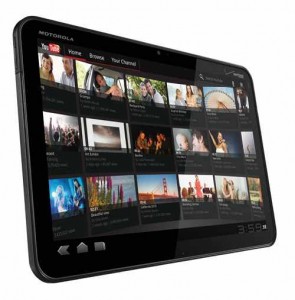 Officially, only the Xoom has DLNA Support built in, but the Skifta application runs on the Streak 7 and not only provides DLNA support, but strong DLNA functionality. This application, created by Qualcomm, is free right now and it allows you to use your tablet to control all of your DLNA compliant devices. Late last year, this spec actually started working, and there is something cool about managing your content from your tablet for you TV and sound systems in your home. Skifta is already being used on the Android 3.0 beta with success, so it should also work with the Xoom when it ships.
Officially, only the Xoom has DLNA Support built in, but the Skifta application runs on the Streak 7 and not only provides DLNA support, but strong DLNA functionality. This application, created by Qualcomm, is free right now and it allows you to use your tablet to control all of your DLNA compliant devices. Late last year, this spec actually started working, and there is something cool about managing your content from your tablet for you TV and sound systems in your home. Skifta is already being used on the Android 3.0 beta with success, so it should also work with the Xoom when it ships.
Operating system
Everyone is all over the map here, with the oldest OS being Apple’s, followed by the Dell Streak which uses the current smartphone version of Android 2.2, then the new Blackberry Tablet OS, and finally the Xoom, with the soon-to-be-released Android 3.0 for tablets. The two to watch are likely Android 3.0 and iOS, due to popularity and focus on the device, but on a sub-10-inch screen the Android 2.2 platform appears to work fine. What this really speaks to is application support, however, and here Apple continues to have a lead with Google a close second.
Application support
The latest counts I have suggest that Blackberry has 4,000 applications, many of which likely don’t look too good on the larger screen. Android has 200,000, but many have not yet been optimized for Android 3.0 yet, and iOS on the iPad. On total numbers and application quality, I give Apple a strong edge here, but folks only seem to buy a few applications on their iPad. You may be surprised to find the ones you want on both the Apple and Google platform offerings. RIM, however, just isn’t as widely supported.
Flash support
 As you would expect, this is everyone but Apple. The iPad’s lack of Flash support can be a problem on Flash-optimized websites, and for viewing some videos on the web. It is more of an annoyance than anything else, but if you find yourself hitting a Flash wall painfully, it could force you to consider a non-Apple product. There was a time on smartphones when no one could support Flash. This has changed and it does continue to make Apple odd man out. I’m not expecting this to be corrected either with the iPad 2.
As you would expect, this is everyone but Apple. The iPad’s lack of Flash support can be a problem on Flash-optimized websites, and for viewing some videos on the web. It is more of an annoyance than anything else, but if you find yourself hitting a Flash wall painfully, it could force you to consider a non-Apple product. There was a time on smartphones when no one could support Flash. This has changed and it does continue to make Apple odd man out. I’m not expecting this to be corrected either with the iPad 2.
Cameras and quality
The first iPad is missing a camera, but we expect the iPad 2 to have a 5-megapixel camera on the back and a 3.2-megapixel on the front. This is similar to the Playbook. Next is the Xoom with a 5-megapixel on the back and a 2-megapixel on the front, and then the Streak with a 5-megapixel on the back and a 1.3-megapixel on the front. For video conferencing, you don’t need a lot of resolution and the tendency is to want to keep the quality of the stream low so you don’t blow out your data plan (especially your foreign roaming charges). In terms of recording video, the Playbook does a whopping 1080p, creating huge data files (I’m sure you can dial it down) and the Streak 7 and Xoom shoot 720p.
Sensors
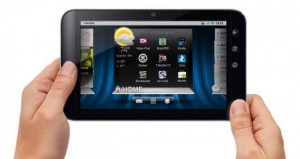 The Xoom is the clear champ here, with an accelerometer, light sensor, proximity sensor, gyroscope, compass, and barometer. The Streak 7 loses the gyroscope and barometer to drop into number two, the iPad comes next losing the proximity sensor, and the Playbook gets back the proximity sensor but loses the compass (I think the compass is more important in a device of this class) to come in a close fourth. Sensors are used for games and applications; the more you have the more capable the device will be. Think of this as obsolescence protection because you can always add that new application but if you don’t have a sensor that will allow it to work properly you’ll be unhappy. It is as yet unclear what new sensors the iPad 2 will have but I expect it will pick up one or two.
The Xoom is the clear champ here, with an accelerometer, light sensor, proximity sensor, gyroscope, compass, and barometer. The Streak 7 loses the gyroscope and barometer to drop into number two, the iPad comes next losing the proximity sensor, and the Playbook gets back the proximity sensor but loses the compass (I think the compass is more important in a device of this class) to come in a close fourth. Sensors are used for games and applications; the more you have the more capable the device will be. Think of this as obsolescence protection because you can always add that new application but if you don’t have a sensor that will allow it to work properly you’ll be unhappy. It is as yet unclear what new sensors the iPad 2 will have but I expect it will pick up one or two.
Max storage
32GB is likely enough for a device in this class, and you can get there with every device. However, the Streak starts off with 16GB, the Xoom with better than twice that, and with both you can add 32GB of Flash memory yourself. Neither RIM nor Apple provides an upgrade path, so while you can buy a 64GB device, if you find you need more memory with your 16GB starter system, you have to replace it. To put this in perspective, a high-speed 32GB SD card costs about $50 on Amazon, going from an iPad 16GB to an iPad 32GB will cost you $599, (a $100 difference, even if you were able to sell your first device at face value). You can clearly understand why Apple and RIM want you do be motivated to buy a new tablet rather than new memory, but as a consumer this is a huge disadvantage. The Xoom leads, followed by the Streak 7 and the RIM and iPad bring up the rear.
Portability
It doesn’t do you much good to have a device you don’t carry. The smaller the device, the more likely someone is going to carry it. This gives the 7-inch products from RIM an advantage, and the fact that Dell has a line of devices starting at 5 inches gives the Streak line the strongest line advantage. However, since you’re only likely to buy one of them, this advantage depends on which one you buy. The rest are on a one-size fits all tier. While that clearly has worked for Apple, I can’t think of any other CE product, including the iPod, that didn’t benefit from a deeper size range in the line. Dell leads here.
Battery life
Here, Dell doesn’t do so well. The bar is 10 hours, and all but the Steak reach it. The Streak 7 traded off weight for battery life, and gets a projected four hours. That’s about what a laptop gets normally, but is well behind what is needed in this class. None of these devices allow for replaceable batteries.
The perfect product
The 7-inch size is kind of a ‘tweener size, but then, historically, 10-inch wasn’t popular before the iPad, so this isn’t set in stone. The 7-inch screen gains a lot of portability, and doesn’t seem to lose much in usefulness. I used the 5-inch for a while, and liked it better than the more typical sub-4-inch displays found on most smartphones. So, size is a matter of taste and portability. For a data device, 4G support is critical, and if you are going to buy a 3G/4G plan, the tethering option is important as well. Choices favor Dell, and tethering favors both Dell and Motorola. The iPad probably comes in close to last in this matchup, but that’s because it is almost a year old and many of these devices haven’t yet shipped. The iPad 2 will clearly be at least competitive.
Dell’s biggest advantage is having a line of similar devices, and its biggest disadvantage is battery life. If I were to rank these products, it would be Xoom first, the Dell Streak line second, Playbook third, and the iPad fourth, but I believe the iPad 2 on Verizon, when it arrives, will beat the Xoom. I also believe that going forward, we are going to see feature wars between these devices. Oh, and one final thing: Up until now, the only company selling lots of these things was Apple. While doubtful, there is still a chance Apple could corner this market like it did with MP3 players, or it could go the way of the netbook. On the other hand, Android 3.0 offering is looking like it could be a giant killer which will make for an interesting battle.
xClusive Research work by TecHead, e-NewsDesk







